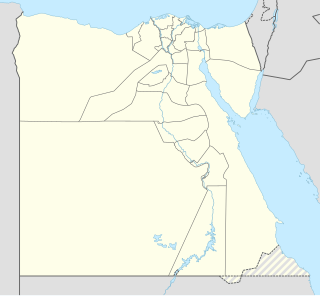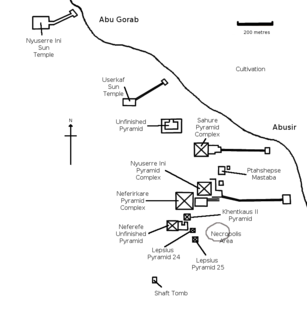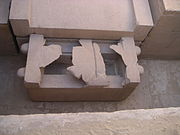
Khafra was an ancient Egyptian king (pharaoh) of the 4th Dynasty during the Old Kingdom. He was the son of Khufu and the throne successor of Djedefre. According to the ancient historian Manetho, Khafra was followed by king Bikheris, but according to archaeological evidence he was instead followed by king Menkaure. Khafra was the builder of the second largest pyramid of Giza. The view held by modern Egyptology at large continues to be that the Great Sphinx was built in approximately 2500 BC for Khafra. Not much is known about Khafra, except from the historical reports of Herodotus, writing 2,000 years after his life, who describes him as a cruel and heretical ruler who kept the Egyptian temples closed after Khufu had sealed them.

Teti, less commonly known as Othoes, sometimes also Tata, Atat, or Athath in outdated sources, was the first pharaoh of the Sixth Dynasty of Egypt. He is buried at Saqqara. The exact length of his reign has been destroyed on the Turin King List but is believed to have been about 12 years.

Neferirkare Kakai was an ancient Egyptian pharaoh, the third king of the Fifth Dynasty. Neferirkare, the eldest son of Sahure with his consort Meretnebty, was known as Ranefer A before he came to the throne. He acceded the day after his father's death and reigned for eight to eleven years, sometime in the early to mid-25th century BCE. He was himself very likely succeeded by his eldest son, born of his queen Khentkaus II, the prince Ranefer B who would take the throne as king Neferefre. Neferirkare fathered another pharaoh, Nyuserre Ini, who took the throne after Neferefre's short reign and the brief rule of the poorly known Shepseskare.

Menkauhor Kaiu was an Ancient Egyptian pharaoh of the Old Kingdom period. He was the seventh ruler of the Fifth Dynasty at the end of the 25th century BC or early in the 24th century BC.

Djedkare Isesi was a pharaoh, the eighth and penultimate ruler of the Fifth Dynasty of Egypt in the late 25th century to mid-24th century BC, during the Old Kingdom. Djedkare succeeded Menkauhor Kaiu and was in turn succeeded by Unas. His relations to both of these pharaohs remain uncertain, although it is often conjectured that Unas was Djedkare's son, owing to the smooth transition between the two.

Neferefre Isi was an ancient Egyptian pharaoh of the Fifth Dynasty during the Old Kingdom period. He was most likely the eldest son of pharaoh Neferirkare Kakai and queen Khentkaus II. He was known as prince Ranefer before he ascended to the throne.

Nyuserre Ini was an Ancient Egyptian pharaoh, the sixth ruler of the Fifth Dynasty during the Old Kingdom period. He is credited with a reign of 24 to 35 years depending on the scholar, and likely lived in the second half of the 25th century BCE. Nyuserre was the younger son of Neferirkare Kakai and queen Khentkaus II, and the brother of the short-lived king Neferefre. He may have succeeded his brother directly, as indicated by much later historical sources. Alternatively, Shepseskare may have reigned between the two as advocated by Miroslav Verner, albeit only for a few weeks or months at the most. The relation of Shepseskare with Neferefre and Nyuserre remains highly uncertain. Nyuserre was in turn succeeded by Menkauhor Kaiu, who could have been his nephew and a son of Neferefre.

Shepseskare or Shepseskara was an Ancient Egyptian pharaoh, the fourth or fifth ruler of the Fifth Dynasty during the Old Kingdom period. Shepseskare lived in the mid-25th century BC and was probably the owner of an unfinished pyramid in Abusir, which was abandoned after a few weeks of work in the earliest stages of its construction.

Abusir is the name given to an Egyptian archaeological locality – specifically, an extensive necropolis of the Old Kingdom period, together with later additions – in the vicinity of the modern capital Cairo. The name is also that of a neighbouring village in the Nile Valley, whence the site takes its name. Abusir is located several kilometres north of Saqqara and, like it, served as one of the main elite cemeteries for the ancient Egyptian capital city of Memphis. Several other villages in northern and southern Egypt are named Abusir or Busiri. Abusir is one relatively small segment of the extensive "pyramid field" that extends from north of Giza to below Saqqara. The locality of Abusir took its turn as the focus of the prestigious western burial rites operating out of the then-capital of Memphis during the Old Kingdom 5th Dynasty. As an elite cemetery, neighbouring Giza had by then "filled up" with the massive pyramids and other monuments of the 4th Dynasty, leading the 5th Dynasty pharaohs to seek sites elsewhere for their own funerary monuments.

Khentkaus II was a royal woman who lived in Ancient Egypt. She was a wife of Egyptian king Neferirkare Kakai of the Fifth Dynasty. She was the mother of two kings, Neferefre and Nyuserre Ini.

Ptahshepses was the vizier and son-in-law of the Fifth Dynasty pharaoh Nyuserre Ini. As such he was one of the most distinguished members of the royal court. Ptahshepses' mastaba complex in Abusir is considered by many to be the most extensive and architecturally unique non-royal tomb of the Old Kingdom.

Kawab is the name of an ancient Egyptian prince of the 4th Dynasty. He was the eldest son of King Khufu and Queen Meritites I. Kawab served as vizier and was buried in the double mastaba G 7110 - 7120 in the east field which is part of the Giza Necropolis.
Meritites, also spelled Meryetites, Meritates, etc. (mr.t-ỉt=s; “beloved of her father”) was an ancient Egyptian female name. Its notable bearers were:

Meresankh II was a Queen of Egypt who lived during 4th Dynasty.

Meritites II or Meritites A was a 4th Dynasty Princess of Ancient Egypt, and probably a daughter of King Khufu. She may have been a daughter of Meritites I based on the fact that this queen is mentioned in mastaba G 7650. She married the Director of the Palace Akhethotep and she had several children with her husband. Meritites and her husband shared a mastaba G 7650 in Giza.
Khufukhaf II was an ancient Egyptian high official during the Old Kingdom period. Likely born during the 4th Dynasty, Khufukhaf died during the reign of pharaoh Nyuserre Ini of the mid 5th Dynasty. In modern Egyptology, he is also called Khufukhaf B or Khufukhaf the Younger to distinguish him from his probable father or grandfather Khufukhaf I.
Reptynub was a Queen during the Fifth Dynasty of Egypt. She was the wife of King Nyuserre Ini. She was possibly a mother of Menkauhor Kaiu.

The Double Pyramid also known as Lepsius XXV designates a pair of adjacent monuments located on the south-eastern edge of the Abusir necropolis, south of the pyramid Lepsius XXIV and of the pyramid of Khentkaus II. The pair of monuments was built during the mid-Fifth Dynasty, likely during Nyuserre Ini's reign, for two female members of the extended royal family.

The Lepsius XXIV Pyramid is an Egyptian pyramid, which was probably built for a wife of King Nyuserre Ini. The largely destroyed 5th Dynasty structure is located in the pyramid field of Abusir, east of the Pyramid of Neferefre and south of the Pyramid of Khentkaus II.

The Pyramid of Nyuserre is a mid 25th century BC pyramid complex built for the Egyptian pharaoh Nyuserre Ini of the Fifth Dynasty. During his reign, Nyuserre had the unfinished monuments of his father, Neferirkare Kakai, mother, Khentkaus II, and brother, Neferefre, completed, before commencing work on his personal pyramid complex. He chose a site in the Abusir necropolis between the complexes of Neferirkare and Sahure, which, restrictive in area and terrain, economized the costs of labour and material. Nyuserre was the last king to be entombed in the necropolis, whilst his successors chose to be buried elsewhere.

















